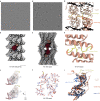Structural landscape of the respiratory syncytial virus nucleocapsids
- PMID: 37714861
- PMCID: PMC10504348
- DOI: 10.1038/s41467-023-41439-8
Structural landscape of the respiratory syncytial virus nucleocapsids
Abstract
Human Respiratory Syncytial Virus (HRSV) is a prevalent cause of severe respiratory infections in children and the elderly. The helical HRSV nucleocapsid is a template for the viral RNA synthesis and a scaffold for the virion assembly. This cryo-electron microscopy analysis reveals the non-canonical arrangement of the HRSV nucleocapsid helix, composed of 16 nucleoproteins per asymmetric unit, and the resulting systematic variations in the RNA accessibility. We demonstrate that this unique helical symmetry originates from longitudinal interactions by the C-terminal arm of the HRSV nucleoprotein. We explore the polymorphism of the nucleocapsid-like assemblies, report five structures of the full-length particles and two alternative arrangements formed by a C-terminally truncated nucleoprotein mutant, and demonstrate the functional importance of the identified longitudinal interfaces. We put all these findings in the context of the HRSV RNA synthesis machinery and delineate the structural basis for its further investigation.
© 2023. Springer Nature Limited.
Conflict of interest statement
The authors declare no competing interests.
Figures






Similar articles
-
In vitro trackable assembly of RNA-specific nucleocapsids of the respiratory syncytial virus.J Biol Chem. 2020 Jan 17;295(3):883-895. doi: 10.1074/jbc.RA119.011602. Epub 2019 Dec 10. J Biol Chem. 2020. PMID: 31822560 Free PMC article.
-
Generation and Assembly of Virus-Specific Nucleocapsids of the Respiratory Syncytial Virus.J Vis Exp. 2021 Jul 27;(173):10.3791/62010. doi: 10.3791/62010. J Vis Exp. 2021. PMID: 34398139 Free PMC article.
-
Structural plasticity of mumps virus nucleocapsids with cryo-EM structures.Commun Biol. 2021 Jul 2;4(1):833. doi: 10.1038/s42003-021-02362-0. Commun Biol. 2021. PMID: 34215847 Free PMC article.
-
Modulation of Host Immunity by Human Respiratory Syncytial Virus Virulence Factors: A Synergic Inhibition of Both Innate and Adaptive Immunity.Front Cell Infect Microbiol. 2017 Aug 16;7:367. doi: 10.3389/fcimb.2017.00367. eCollection 2017. Front Cell Infect Microbiol. 2017. PMID: 28861397 Free PMC article. Review.
-
Insights into Paramyxovirus Nucleocapsids from Diverse Assemblies.Viruses. 2021 Dec 10;13(12):2479. doi: 10.3390/v13122479. Viruses. 2021. PMID: 34960748 Free PMC article. Review.
Cited by
-
From structural polymorphism to structural metamorphosis of the coat protein of flexuous filamentous potato virus Y.Commun Chem. 2024 Jan 17;7(1):14. doi: 10.1038/s42004-024-01100-x. Commun Chem. 2024. PMID: 38233506 Free PMC article.
-
Structure of the N-RNA/P interface indicates mode of L/P recruitment to the nucleocapsid of human metapneumovirus.Nat Commun. 2023 Nov 22;14(1):7627. doi: 10.1038/s41467-023-43434-5. Nat Commun. 2023. PMID: 37993464 Free PMC article.
-
Introduction to Respiratory Syncytial Virus.Methods Mol Biol. 2025;2948:1-17. doi: 10.1007/978-1-0716-4666-3_1. Methods Mol Biol. 2025. PMID: 40879898
-
Clinical Insights and Advancements in Human Metapneumovirus Management and Prognosis.Discoveries (Craiova). 2025 Mar 31;13(1):e204. doi: 10.15190/d.2025.3. eCollection 2025 Jan-Mar. Discoveries (Craiova). 2025. PMID: 40351504 Free PMC article. Review.
-
Single-Particle Electron Microscopy Analysis of Respiratory Syncytial Virus Protein Complexes.Methods Mol Biol. 2025;2948:159-180. doi: 10.1007/978-1-0716-4666-3_11. Methods Mol Biol. 2025. PMID: 40879908
References
Publication types
MeSH terms
Substances
LinkOut - more resources
Full Text Sources

